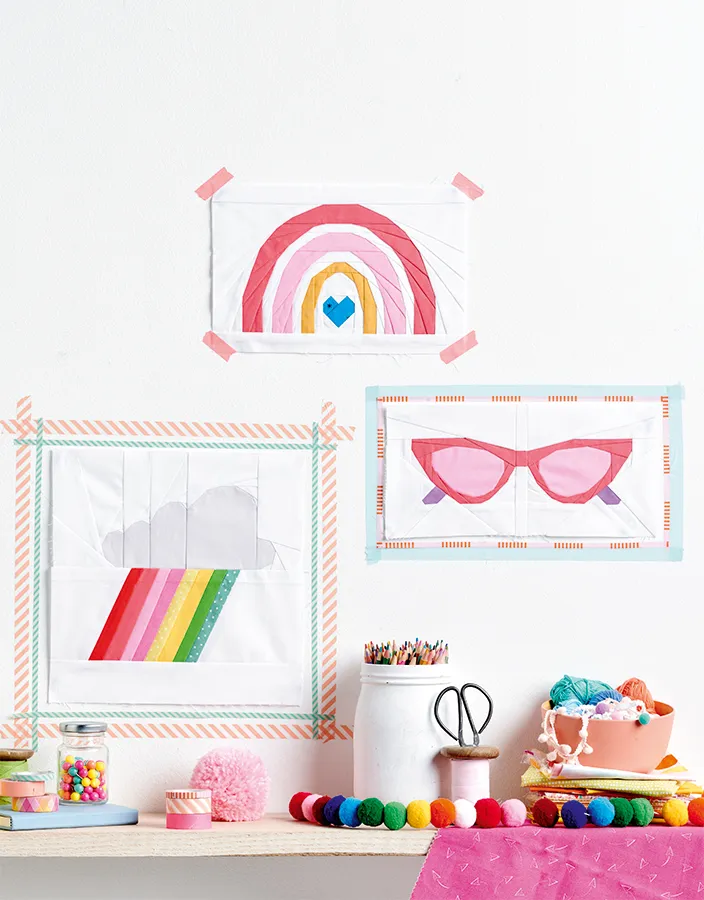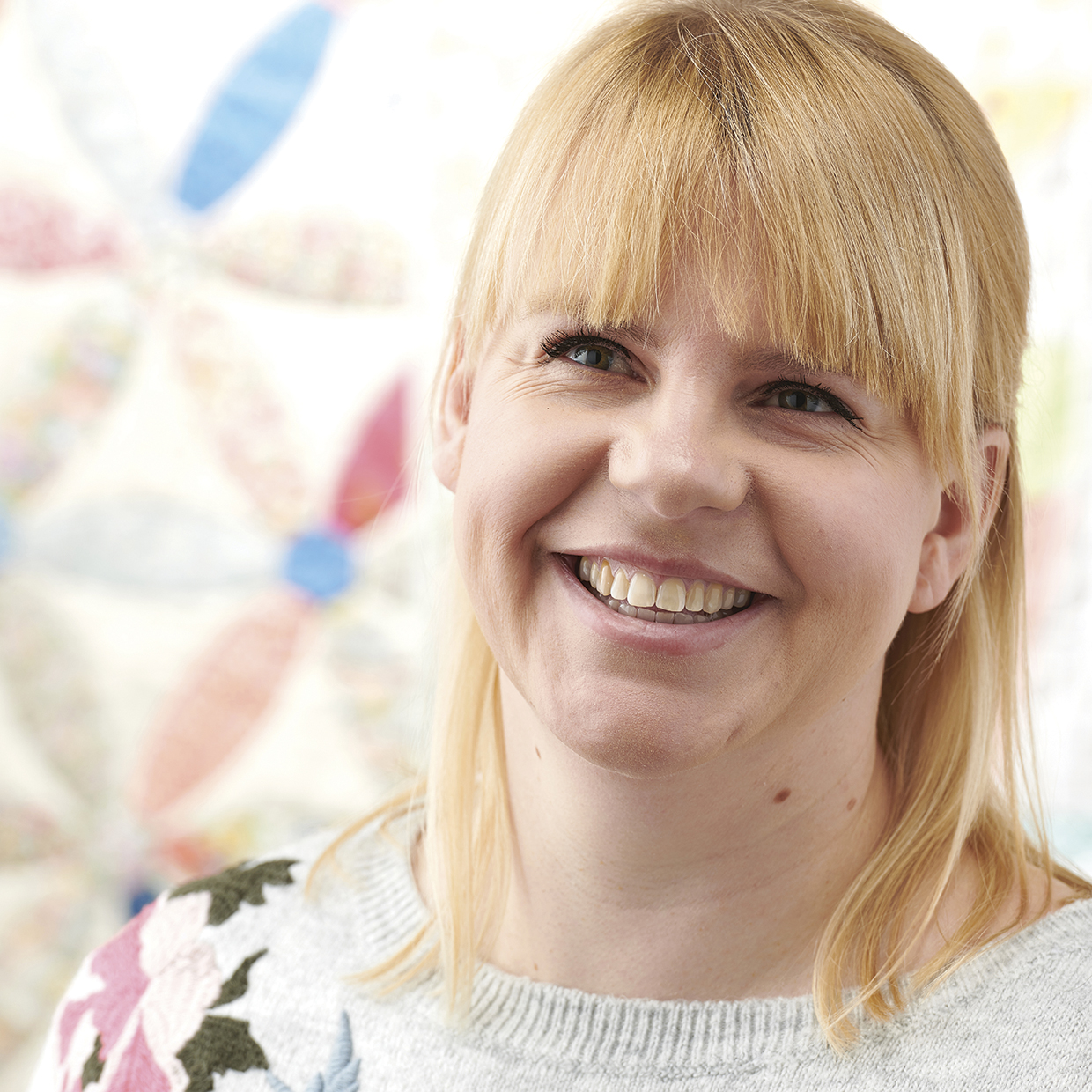Inspiring quilt blocks for quilters of all abilities
When it comes to quilt blocks, there are hundreds you can choose from, and about the same amount of variations of blocks out there too!
- Quilting for beginners: your go-to guide!
- Sashiko Quilting made easy
- Best rotary cutters for fabric, quilting and dressmaking
In this guide, we look at the most popular and most useful quilt blocks we love to use over and over again. We will also look at some units too – that's parts that make up many blocks, or can be blocks in their own right.
Quilt block library – useful units in quilt blocks
1. Flying Geese

Flying Geese is a unit of patchwork (or a block of patchwork), which gets its name from the centre triangle – meant to represent a goose in flight, and the two smaller triangles on each side, representing the sky. With a few simple steps you can turn rectangles and squares of fabric into these most versatile of quilt blocks.
- Learn to make Flying Geese
2. Half-square triangles (HST)

Half-square triangles are one of the most popular and versatile units in patchwork and quilt making.
A half-square triangle unit of fabric – often abbreviated to ‘HST’ – is simply two right-angled triangles sewn together. These triangles are usually made up of different fabrics that contrast each other in some way, such as light and dark.
- Learn to make half-square triangles
3. Quarter-square triangles (HST)

Quarter-square triangle units – often abbreviated to ‘QST’ – are square patchwork units that are made up of four equally sized 90-degree triangles.
They can also be made from two HSTs. Layer the two HST units right sides together and stitch diagonally in the opposite direction to form the QST units.
- Learn to make quarter-square triangles
Quilt block library – 10 of the most popular quilt blocks
1. Four-Patch/Nine-Patch bocks

Four-patch and nine-patch quilt blocks are really simple to make. Simply cut a batch of fabric squares or strips, then sew them together to make larger squares, or mix and match your fabrics to create a checkered effect.
These two easy quilt blocks patterns will soon become the building blocks of your quilting know-how.
- Learn how to make four-patch and nine-patch blocks and try it with our Free friendship Braid quilt

Looking for a brilliant block pattern? Look no further than our Rock-a-bye-baby quilt pattern.
2. Log Cabin block

The Log Cabin design is a very old, traditional block design that is loved the world over and is probably one of the best-known patchwork blocks.
To pioneers travelling West, it symbolised home, warmth, love and security. The centre square of the block was done in red to represent the hearth, the focal point of life in a cabin or home.
The basic Log Cabin design is worked around a centre square, with strips added in a clockwise or anti-clockwise direction. The number of ‘logs’ or ‘rounds’ can be whatever you choose.
The way that the strips are added can create a two-tone look to the block if one side uses predominantly dark colours and the other side uses light colours. The blocks are usually machine pieced, but they can also be made using templates or with foundation paper piecing.
- Learn how to make a Log Cabin blocks and make our free log cabin quilt pattern

Explore the Log Cabin quilt’s history, from its very beginnings to modern interpretations, then start sewing your own 'cabin in the sky' log cabin quilt project with our Log Cabin Quilts Special Edition PDF, available in our online store.
3. Pineapple block

The Pineapple block is a variation of the Log Cabin block. Similar to making a Courthouse Steps block, the Pineapple block is usually assembled using strips added in rounds, normally on opposite sides of a square and the opposite corners, then trimmed after each round.
We love this block for its varied effects, created by the careful placement of contrast in fabrics versus a random, scrappy layout.
- Learn how to make a pineapple block
4. Jacob’s Ladder block

Jacob's Ladder is a very old quilt block pattern, dating to before the American Revolutionary War and is classified as a pioneer quilt pattern.
Reading the Bible was a big part of everyday pioneer life, and often quilt blocks were given biblical names to reflect the belief and conviction of the spiritual life. Jacobs Ladder is spoken about in Genesis where Jacob dreams of a ladder to heaven during his flight from his brother Esau.
The quilt block is characterised by strong diagonal lines running in both directions through the block and is a nine-patch quilt block, which means it’s made up of nine sections or units as we call them.
- Learn to make a Jacob’s Ladder block

Put your Jacob's Ladder blocks into practice with the Juniper Christmas quilt pattern in our online store.
5. Churn Dash block

Originating in the early 1800s, the name is a result of the resemblance to a butter churn. The “churn” refers to the mixing container, and the “dash” is the stirring stick. The Churn Dash is made up of half-square triangles and bar units.
- Learn to make a Churn Dash block

Master the Churn Dash block with our Hunters Star quilt pattern.
6. Bear Paw block

As the name states, the block looks like a giant bear paw and is made from squares and half-square triangles.
One of the most popular theories about the origins of the Bear Paw quilt pattern is that the quilt block was used to guide escaped slaves to food and water in the days of the underground railroad. This Bear Paw code meant to follow a mountain trail, out of view, and then follow an actual bear's trail, which would lead to water and food.
- Learn how to make a Bear Paw block

Find your wildest fabrics and give it a try with our Modern bear paw quilt pattern.
7. Friendship Star block

In the days of the pioneers, Friendship Star quilts were made for women about to embark on a pioneer journey. Friends she was leaving behind would sew these simple stars and embroider their name in the centre of the star.
The quilt would then be presented to their friend to take along with her on the journey west. It's very beginner-friendly as it's made with squares and half-square triangles.
- Learn how to make a Friendship Star block
8. Sawtooth Star block

The Sawtooth Star is a simple block with endless potential. A history that goes all the way back to 1884, when it was first published in Farm & Fireside Magazine, this humble block was designed to reference the teeth of a saw.
For Native Americans, the star is a sacred symbol equated with honour. Their Sawtooth Star quilts (called Morning Star) were a symbolic way to honour and protect the recipient as they travelled through life.
- Learn to make a Sawtooth Star block and make our free Sawtooth Star quilt pattern

Create a stunning sawtooth star you can cosy up with by making the Velvet patchwork cushion pattern from our online shop.
9. Ohio Star block

The Ohio Star block is rich in history and has been around since the early 1800's. Like a lot of blocks, it's known by many names, depending on geographic location or time period.
It’s a nine-patch block made of quarter-square triangles around a central square.
- Learn to make an Ohio Star block and use it in our Free Ohio Star quilt pattern
10. Lone Star block

The Lone Star block is an eight-point star design. It is perennially popular and makes a wonderful centrepiece for a quilt, especially a medallion quilt.
Traditionally, a Lone Star block was made with individual 45-degree diamonds, joined in rows to create larger diamond segments.
Eight of these were joined together with background squares and triangles. Y-seams were used in the construction, or the star was hand-applied to a background.
Today, Lone Star is often made with strip piecing. This method is not only quicker but more accurate.
- Learn to make a Lone Star block

Show off your skills with the Kaleidoscopic Delight lone star quilt pattern.
Why we love these 10 quilt blocks
Although there is nothing as fun as learning a new block, we have certain favourites we go back to over and over again.
Many of the blocks and units above are used in multiple quilt patterns, so are good to master, and can be tackled from beginner quilters right up to advanced ones. This makes them great to get in your quilting repertoire.
Quilt blocks that look tricky but are beginner-friendly
We've collected over 30 easy quilt blocks that look difficult for you to explore. All these quilt blocks are beginner-friendly but once finished will look like they've been stitched by a professional.



